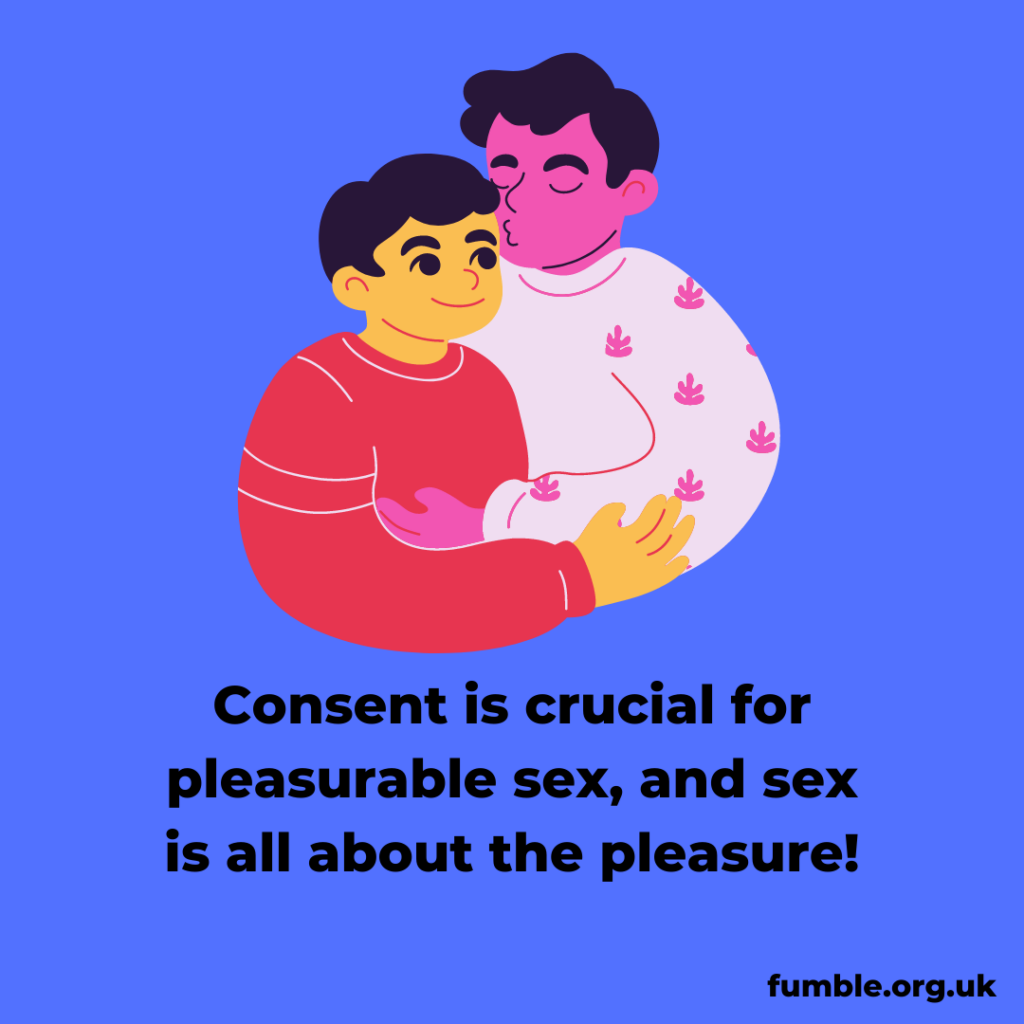Enjoying sex and intimacy as a trans+ person
Having sex while navigating a binary landscape and gender dysphoria can be difficult, but maybe we can help
Sex isn’t gendered! Or, at least, it shouldn’t be. But the gender binary (male/female) and its stereotypes get everywhere, and that can include the roles we’re expected to ‘take on’ while having sex.
In films, TV shows and porn (and more!), we tend to see the same ‘script’ for heterosexual (straight) sex repeated over and over again. The man is expected to initiate sex, always be ‘up for it’ and take a more active role (e.g. being on top, dictating the pace, sex finishes when he orgasms). The woman, on the other hand, is expected to wait until he initiates, be more passive, and to prioritise the man’s pleasure.
It can feel really frustrating not seeing yourself represented on screen. But a lack of representation doesn’t mean other sexual relationships don’t exist. (Thankfully this is starting to change! For example, the last season of Sex Education has a groundbreaking sex scene between characters Abbi and Roman.)
Regardless of our sexuality, whether we’re heterosexual or not, we don’t have to ‘take on’ these gender roles. But it can be helpful to recognise them, so that we can shake them off. Some types of sex may feel more affirming for you personally. But anyone can enjoy any type of sex and it doesn’t mean anything about your gender.
As long as everyone involved consents to the sex you are having, and is feeling comfortable and safe, it’s okay. Work out whatever feels good for you and your sexual partner(s).

Having said that, knowing that sex doesn’t say anything about your gender isn’t the same as feeling it. Of course some types of sex and intimacy may not feel good or make you feel dysphoric.
We’ve pulled together some tips to help you navigate sexual intimacy as a trans+ person. This isn’t about having great sex *despite* being trans+. Absolutely not. Understanding more about our bodies, what we enjoy, and how we can communicate what we enjoy, is what makes sex great, regardless of your gender identity.
Types of sex
Sex education in school often just teaches about penetrative penis-in-vagina sex within heterosexual (straight) relationships. But sex is so much more than that. There are many other types of sex and intimacy you can enjoy and that can affirm your gender:
🔥 Muffing: a way to finger trans-women, transfeminine and non-binary people who haven’t had bottom surgery. You insert fingers or small sex toys (such as bullet vibrators) into the inguinal channels. These are small holes either side of the genitals (where the testicles go when tucking). The term was coined by Mira Bellwether in her zine F*cking Trans Women, which has a more detailed guide.
🔥 Sex toys are great! You can use them in and around any genitals, in whatever way feels good. Sex toys can also be good for affirming your gender during sex. For example, some trans men, transmasculine and non-binary people feel affirmed when using strap ons.
🔥 Anal sex: the anus isn’t gendered – everyone has one! This doesn’t just mean penetration, try using toys, fingers or your mouth around the area.

Sex can also be different for people who have had bottom surgery. The book Trans Sex by Kelvin Sparks has great information about this. Make sure you speak to your doctor about navigating sex after surgery. For example, they’ll be able to tell you how long you should wait after surgery before having sex.
Setting boundaries
Setting boundaries is essential for any sexual relationship (whether it’s a more casual hook-up or long-term relationship). But it can be especially important when trying to avoid triggering dysphoria during an intimate and potentially vulnerable time.
It’s good to try and figure out your boundaries by yourself, where possible. A great way to do this is by masturbating, and seeing what feels good and what doesn’t. Although, keep in mind that sometimes you won’t realise how you feel until you’re in the moment with someone else.
For that reason, it might help to set up a sort of ‘red card, yellow card’ system:
🟡 Choose a ‘yellow card’ word that means: “stop that specific thing but keep going otherwise”. For example, if your partner started touching your chest, this ‘yellow card’ word would communicate that you don’t want them to touch your chest, but you don’t want to stop having sex/being intimate entirely.
🔴 Choose a ‘red card’ word that means: “stop everything immediately”. This communicates your need to stop everything, or at least have a break and check in to decide if you want to continue.
Of course, you may not feel the need to choose alternative words. You can simply say “please don’t touch my chest” or “I want to stop/take a break”. But sometimes it can feel trickier to say this so directly. Having alternative words can make it easier to communicate how you’re feeling.

Everyone has different boundaries. Some people might not have many to share, while others might have a very specific list of things they’re okay with or not okay with. This is all totally valid!
For example, you may feel fine with someone touching you above the waist but not below, or vice versa. You might be comfortable with being touched anywhere, but not okay with penetration. Or maybe you enjoy vaginal penetration but not anal, or the other way around. You may not want your partner’s hands touching you everywhere, but enjoy penetration or them using toys with you. Maybe you prefer to masturbate alongside your partner, or you’d prefer to do all the touching and not be touched by them. Your boundaries may even extend to a simple desire to keep your t-shirt or trousers on for your own comfort.
No matter how specific you feel your boundaries are, we guarantee others have the same needs and it’s not too much to ask that someone respect these. Everyone should feel comfortable and have fun while they’re having sex, that’s the whole point!
Binding during sex
One of the first things you’ll hear when you think about, or start, binding for the first time is that you shouldn’t wear one while exercising or during any strenuous activity. This is important safety advice.
But what if wearing one while having sex could make you feel more present and connected in the moment? Or could help you to enjoy sex more by reducing dysphoric feelings? Is there a way to bind safely while having sex, or should you avoid it where possible?
Wearing a binder while masturbating is likely to be safe, unless your alone time gets particularly energetic or involves a lot of sustained movement of your upper body. However, and this goes for all sexual acts (solo or not), you should always, always prioritise your physical health and wellbeing. If you’re feeling restricted, short of breath or overheating, make sure you take a break from wearing your chest binder.
How active and physical is the type of sex you’re having? The amount of movement and ‘exercise’ involved will determine how much binding might affect your physical health. Where possible, avoid binding while having sex as the restriction could lead to injury.
A sports bra is a much safer option and could provide a similar amount of compression, or at the very least prevent your chest from ‘bouncing’.
Lingerie and underwear
Finding lingerie and underwear that fits and feels good as a trans+ person can be hard. Whether that’s finding more typically ‘feminine’ lingerie that fits comfortably around a penis, or finding more typically ‘masculine’ lingerie that fits as intended when you have a vulva.
Lingerie and underwear can also make it difficult to work around certain toys, such as strap-on dildos, as they’re usually tight-fitting and don’t always leave the extra space these toys need.
There are some options though, such as packing/strap-on underwear like LoveHoney and trans+-oriented lingerie shops like Gaff & Go, which can make the search process that little bit easier. (We link to several retailers in this piece because they have some great guides on their sites and sell gender-inclusive items, which we know are often harder to find. But we’re not affiliated with them and we don’t profit from these links.)
Enjoying certain types of lingerie and underwear can also lead to some amounts of dysphoria, or some confusion around gender expression and presentation. Most clothes are heavily gendered (for example, the idea that skirts and dresses are for girls and women). This is especially the case for lingerie and underwear.
But they don’t have to be! Somebody who usually presents more ‘masculine’ may enjoy wearing typically ‘feminine’ lingerie, or any variation of this, and that’s totally fine. More than ‘fine’, it can be fun!
Presentation does not equal gender. Plenty of people (both cis and trans+) enjoy wearing clothes that don’t meet typical ideas of ‘masculine’ or ‘feminine’ styles, whether that’s underwear or outfits as a whole.
It’s understandable that this may bring up some doubt or discomfort (the gender binary runs deep!). But if it’s something you enjoy, then that’s the most important thing. We know it’s not as simple as telling people they “shouldn’t feel shame”, but clothes are a wonderful and affirming way to express yourself. Sex is meant to be freeing, so go ahead and wear what feels good.
Gender-neutral words
Finding gender-neutral names or gender-affirming words for body parts can be tricky. Although the anatomical words “vagina”, “vulva”, “testicles” and “penis” aren’t inherently gendered, they can still feel dysphoric to use.
Many people also often use slang words during sex (e.g. “p*ssy”, “d*ck”, “c*ck”) and these often have much more of a gendered slant to them. This can cause discomfort and dysphoria.
It’s a good idea to have a think about which words feel affirming and comfy and which don’t (and ask your partner(s) what they are comfortable with too). Just keep in mind that sometimes we don’t know how it’ll feel until we hear the word out loud in the situation! Be patient with yourself and try to enjoy the process. It can be fun to learn what does and doesn’t work for you and your partner(s).
If you’re ever unsure how your partner will feel in the moment, maybe it’s best to not say it. Instead ask afterwards. Or you can just say “you” (i.e., “I want you”) rather than being specific with body parts.
Just like the labels “girlfriend” and “boyfriend”, lots of pet-names can also feel gendered. It’s a good idea to check in with each other before leaping in with common ones like “baby” and “babe”.
Sex doesn’t determine your gender
Whatever type of sex you enjoy, if any, it doesn’t determine your gender. The most important thing is checking that you both/all feel comfortable and safe, as you learn more about what feels good together.
Ajax (they/he) & Ge (they/them)
This article is part of our “Am I Trans?” Translating Sex, Identity & Relationships content series: supporting trans+ young people to access sex and relationships education that is relevant to their experiences and needs. Discover the full series here.
We use the term trans+ in our articles as an umbrella term intended to incorporate all transgender, non-binary, agender and genderfluid identities.
Some of the content addresses potentially triggering topics, such as transphobia and gender dysphoria. We’ve added specific content warnings to these pieces, but please take a moment to check in with yourself and how you’re feeling before diving into the series.
Other support
- Discover the full series
- Support & resources for trans+ young people
- Switchboard helpline – for anyone, anywhere in the country, at any point in their journey to discuss anything related to sexuality and gender identity
- Gendered Intelligence – Knowledge is Power resource for young trans+ people
Read more
Last Reviewed 22 April 2024
Image Credit: The Gender Spectrum Collection





